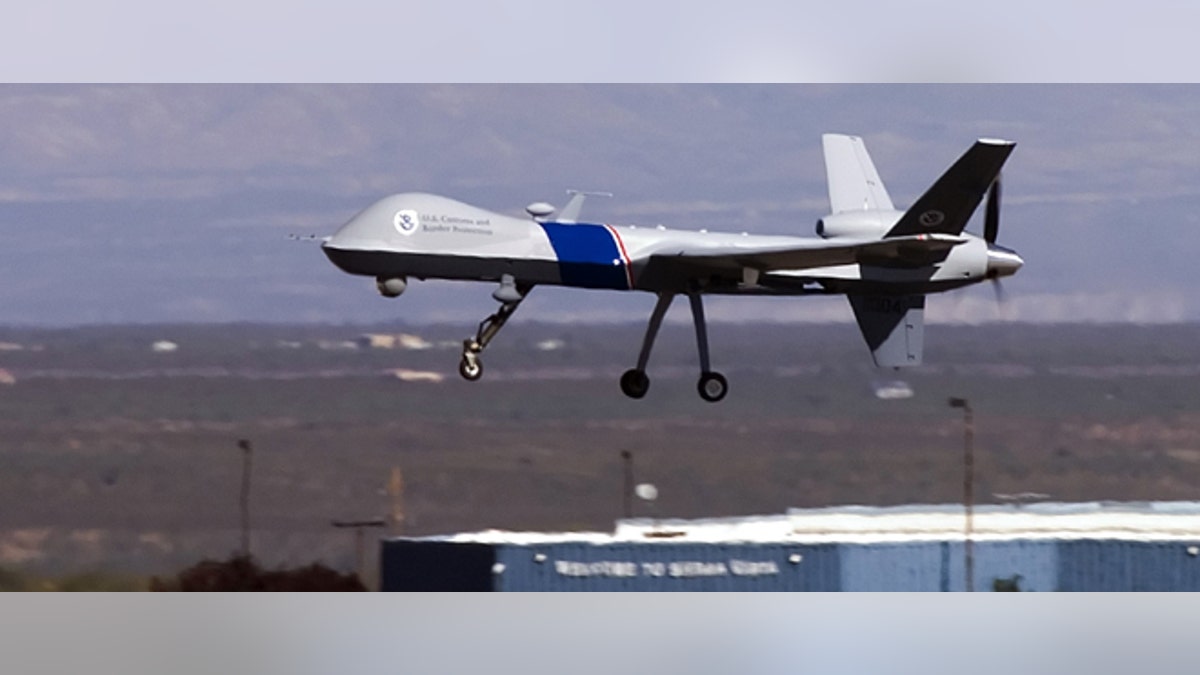
SIERRA VISTA, AZ - OCTOBER 30: The new MQ-9 Predator B, an unmanned surveillance aircraft system, unveiled by the U.S. Customs and Border Protection (CBP), takes off at Libby Army Airfield at Ft. Huachuca October 30, 2006 in Sierra Vista, Arizona. CBP will use the new MQ-9 Predator aircraft to patrol the southern border of the United Sates in order to stop the illegal entry of thousands of Mexican nationals and drug runners who use the vast expanses of the Sonoran desert to cross into southern Arizona, daily. The new unarmed plane flew briefly for the press to show off its surveillance capabilities by pilots of the contractor, General Atomics Aeronautical Systems. Agents of CBP will start training on the use of the aircraft very soon. The Predator will start full scale flight operations along the Mexico-Arizona border today. (Photo by Gary Williams/Getty Images) ((Photo by Gary Williams/Getty Images))
For nearly a decade, the U.S. Customs and Border Protection has touted its drone program as an “effective technology to further enhance operational capabilities,” but according to the agency’s 2014 end of fiscal year report, the results are anything but impressive, fueling new calls for the program to be grounded.
The program has a fleet of 9 Predator drones and the Department of Homeland Security is planning to spend another $443 million for more aircraft to help secure the Mexican border. But a Jan. 6 report from the agency's inspector general is advising against the expansion.
“Notwithstanding the significant investment, we see no evidence that the drones contribute to a more secure border, and there is no reason to invest additional taxpayer funds at this time,” said DHS Inspector General John Roth. “Securing our borders is a crucial mission for CBP and DHS. CBP’s drone program has so far fallen far short of being an asset to that effort.”
The IG report, the second audit of the program since 2012, found there is no reliable method of measuring the program's performance and determined that its impact in stemming illegal
immigration has been minimal.
According to the CBP Fiscal Year Report, the drones flew about 10 percent fewer hours in 2014 than the previous year and 20 percent fewer than in 2013. The missions were credited with contributing to the seizure of just under 1,000 pounds of cocaine in 2014, compared to 2,645 in 2013 and 3,900 in 2012. But apprehensions of illegal immigrants between 2014 and 2013 fell despite the flood of more than 60,000 unaccompanied children coming across the border from Central America.
Combined with the decrease in productivity, the OIG report disclosed the staggering costs to run the program, more than $12,000 per hour when figuring fuel, salaries for operators, equipment and overhead.
Eugene Schied, assistant commissioner of the CBP's office of administration for CBP, said the IG used flawed methods to draw its conclusions.
“The expectations the OIG focused on were based on the program receiving resources that were not obtained, performance measures that were never employed by CBP, or technological capabilities that have been surpassed,” Scheid said. “This context is critical for presenting an accurate assessment of the CBP UAS program’s current performance and achievements.”
Scheid went on to say in his memo that CBP has no plans to acquire additional UAS beyond the one replacement aircraft, nor does the Office of Air and Marine have a contract or funding in place to expand the program.
He said current funding is being used to expand the program’s infrastructure and increase the utilization of the fleet.
Rep. Duncan Hunter (R-Calif.) called for patience with the UAS program.
“It’s a lot cheaper to use drones than helicopters and they can stay in the air longer,” Hunter said. “It still comes down to having the manpower on the ground to support the drone missions.”
Hunter said CBP needs to figure out what the need and use of the UAS is but marry that strategy with human resources on the ground. He made the correlation to the limitations other forms of border security technology such as sensors has in that unless there are agents who can respond quickly to the location, they do little good.
“Right now, I’m not sure CBP has the manpower to support the drone missions,” Hunter said.
What he did express concern over, also given the rise in unaccompanied children crossing the border this year was that, “CBP isn’t doing themselves any favor by flying less hours.”





















